Figure 1 – top view of double-suction pump showing plain elbow (a) creates cavitation while a Suction Diffuser Flex (b) promotes an even fluid distribution.
Centrifugal pumps require well-developed inlet flow. To have a well-developed flow pattern, pump manufacturers’ manuals recommend about 10 diameters of straight pipe upstream of the pump inlet flange. Unfortunately, piping designers and plant personnel must contend with space and equipment layout constraints and can’t always comply with this recommendation. Instead, it is common to use an elbow close-coupled to the pump suction which creates a poorly-developed flow pattern.
Poorly-developed flow can cause cavitation*, excessive vibration and/or poor pump performance. The results can be premature failure of the bearing, seal or impeller, high maintenance costs and high power consumption. Additionally, today’s pumps are not as tolerant to off-design inlet conditions as in the past. Both flow velocity and impeller speed have increased. The result is a lower equipment cost for a given operating point, but the tradeoff is a pump that is more sensitive to inlet conditions.
| *CAVITATION Cavitation is the formation of and subsequent violent collapse of vapor bubbles in liquid. Bubbles or cavities of vapor form in the liquid when static pressure drops below vapor pressure. These bubbles implode when the static pressure rises above vapor pressure, creating a high pressure shock. This implosion can be extremely damaging if it is in the vicinity of a pump component, and creates a distinct noise.Elbows close-coupled to pumps cause cavitation in two ways: First, as liquid passes through an elbow it experiences a drop in pressure on the inside radius. Vapor bubbles form in this area and can be carried into the impeller. Second, non-uniformity of the velocity exiting the elbow can cause local acceleration at the impeller vanes, resulting in low-pressure areas and cavitation. |
For example, consider a double-suction pump with a close-coupled elbow at the inlet. This type of pump is designed for flow to be split evenly between each side of the impeller. The elbow creates turbulence that splits the flow unevenly across the impeller (Figure 1a above). The pump performance can be degraded, and the flow can create an axial imbalance on the shaft which would result in shortened seal, bearing and impeller life.
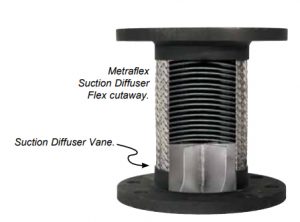 The Suction Diffuser Vane solves this problem by imparting a rotation to the flow upstream of the elbow. Flow leaving the elbow has an even velocity distribution as it enters the pump impeller (Figure 1b above). The pump will perform closer to the factory rating, cavitation and noise will decrease, and seal, bearing and impeller life will improve.
The Suction Diffuser Vane solves this problem by imparting a rotation to the flow upstream of the elbow. Flow leaving the elbow has an even velocity distribution as it enters the pump impeller (Figure 1b above). The pump will perform closer to the factory rating, cavitation and noise will decrease, and seal, bearing and impeller life will improve.
Case History 1
Consider the feed piping configuration of a 3550 rpm double suction pump utilizing an 8-inch Suction Diffuser Vane, shown in Figure 2.
Prior to installing the Suction Diffuser Vanes, operation had been noisy and the pump required an overhaul every four months. A vibration test of the pump prior to the Suction Diffuser Vane installation is shown in Figure 3(a), and just after Suction Diffuser Vane installation is shown in Figure 3(b).
Figure 3 – Comparison vibration spectrum of 3,550 rpm double suction pump with (b) and without (a) a Suction Diffuser Flex.
The dramatic reduction in measured cavitation (6-14 range on the frequency scale) also resulted in a reduction in impeller imbalance (1 on frequency scale) which reduced noise, extended seal, bearing and impeller life, and increased head and flow. Prior to Suction Diffuser Flex installation, three identical pumps in parallel operation were required to deliver the required flow rate. After the Suction Diffuser Flex was installed on each pump, two pumps met the flow rate requirement and the third pump serves as an installed spare.
Case History 2
Performance and maintenance improvements can be achieved with overhung end-suction centrifugal pumps too. Figure 4 shows an end-suction centrifugal pump which required a complete rebuild every six months. After installing the Suction Diffuser Vane, the pump has been operating for 1-1/2 years without a rebuild.
Case History 3
Dramatic improvements have also been witnessed with magnetically-driven pumps, which are extremely sensitive to cavitation and impeller imbalance. In particular, flow in one installation increased 4-1/2% from 1086 gpm to 1135 gpm after the Suction Diffuser Vanes were installed. At the same time, the horsepower draw dropped 7% from 43 to 40 and the discharge head increased 8.6% from 81 to 88 ft. The key benefit, however, was the reduced vibration which eliminated a frequent repair cost of $5000 on the shaft and bearings as well as an occasional severe-failure repair cost of $14,000 per occurrence.
Suction Diffuser vs. the Energy efficient SUCTION DIFFUSER FLEX
Pressure drop is the resistance to flow as a liquid moves thru a pipe. It is caused by the viscous shear within the liquid and turbulence along pipe walls. The more the pressure drop the more energy is consumed to overcome it. The Suction Diffuser Flex is far more efficient compared to a suction diffuser!
WATCH THE VIDEO TO SEE HOW TURBULENT FLOW IS ELIMINATED AT PUMP INTAKE!
DOWNLOAD THE FLOW ANALYSIS OF 2 SUCTION DIFFUSERS & A CRV FLEX USING COMPUTATIONAL FLUID DYNAMICS


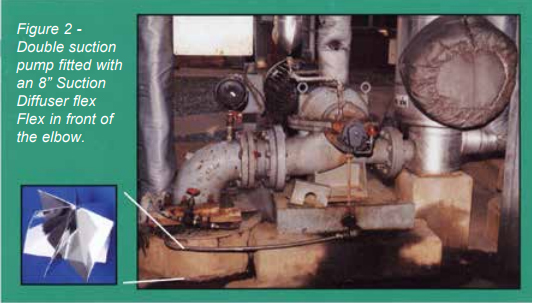
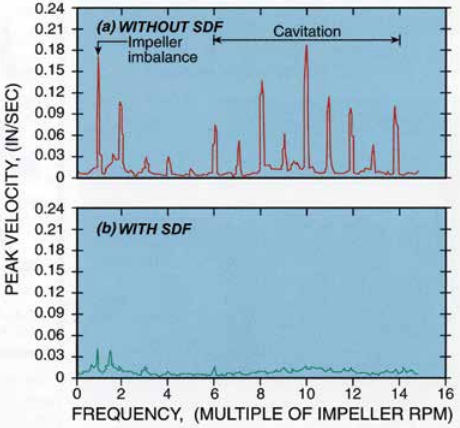
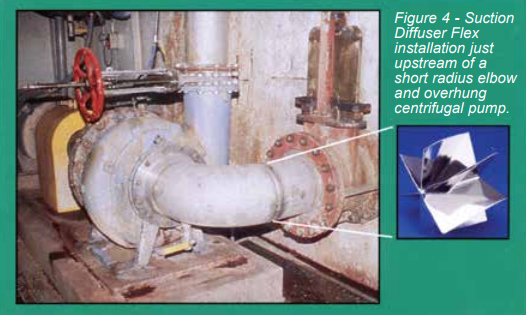
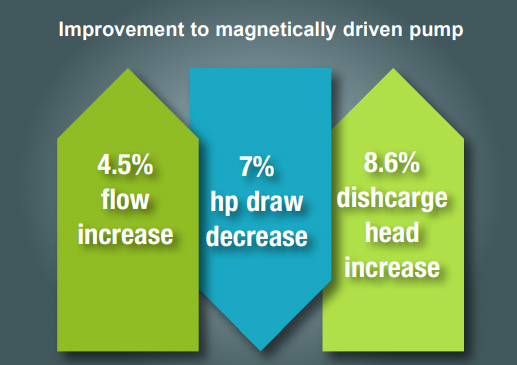



Comments